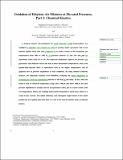| dc.contributor.author | Kopp, Madeleine M. | |
| dc.contributor.author | Donato, Nicole S. | |
| dc.contributor.author | Petersen, Eric L. | |
| dc.contributor.author | Metcalfe, Wayne K. | |
| dc.contributor.author | Burke, Sinéad M. | |
| dc.contributor.author | Curran, Henry J. | |
| dc.date.accessioned | 2016-11-09T11:22:26Z | |
| dc.date.available | 2016-11-09T11:22:26Z | |
| dc.date.issued | 2014-03-27 | |
| dc.identifier.citation | Kopp, MM,Petersen, EL,Metcalfe, WK,Burke, SM,Curran, HJ (2014) 'Oxidation of Ethylene-Air Mixtures at Elevated Pressures, Part 2: Chemical Kinetics'. Journal Of Propulsion And Power, 30 :799-811. | en_IE |
| dc.identifier.issn | 1533-3876 | |
| dc.identifier.uri | http://hdl.handle.net/10379/6147 | |
| dc.description | Journal article | en_IE |
| dc.description.abstract | A chemical kinetics submechanism for small molecular weight hydrocarbons was modified by adjusting rate constants to produce better agreement with recent ethylene ignition delay time data compared with an earlier version of the mechanism, for temperatures from 1003 to 1401 K, at pressures between 1.1 and 24.9 atm, and for equivalence ratios from 0.3 to 2.0. The improved mechanism captures the pressure and equivalence ratio behavior seen in the data at these intermediate temperatures, such as the smaller-than-expected effect of equivalence ratio at the higher temperatures and an apparent lack of pressure dependence at fuel-lean conditions. By using detailed sensitivity analyses, the important reactions were identified, rectifying the model simulations in predicting the observed experimental behavior of the data in this study. In fact, when the model is used to extend the temperature range above 1400 K and below 1000 K, the same pressure dependence is actually seen for all equivalence ratios, just to a lesser extent at the test temperatures. Hence, the resulting hydrocarbon mechanism is much more robust as a result of this exercise. The initial deficiency and subsequent improvement of the model justify the new ignition delay time data from the companion paper to this study as well as the need for further study on ethylene kinetics. | en_IE |
| dc.description.sponsorship | National Science Foundation, Grant Number CBET-0832561; Saudi Aramco | en_IE |
| dc.format | application/pdf | en_IE |
| dc.language.iso | en | en_IE |
| dc.publisher | American Institute of Aeronautics and Astronautics | en_IE |
| dc.relation.ispartof | Journal Of Propulsion And Power | en |
| dc.rights | Attribution-NonCommercial-NoDerivs 3.0 Ireland | |
| dc.rights.uri | https://creativecommons.org/licenses/by-nc-nd/3.0/ie/ | |
| dc.subject | Rate coefficients | en_IE |
| dc.subject | Low temperatures | en_IE |
| dc.subject | Shock waves | en_IE |
| dc.subject | Ignition | en_IE |
| dc.subject | Propene | en_IE |
| dc.subject | Oxygen | en_IE |
| dc.subject | Intermediate | en_IE |
| dc.subject | Hydrocarbon | en_IE |
| dc.subject | Transition | en_IE |
| dc.subject | Pyrolysis | en_IE |
| dc.title | Oxidation of ethylene-air mixtures at elevated pressures, part 2: chemical kinetics | en_IE |
| dc.type | Article | en_IE |
| dc.date.updated | 2016-10-20T09:31:16Z | |
| dc.identifier.doi | 10.2514/1.B34891 | |
| dc.local.publishedsource | http://dx.doi.org/10.2514/1.B34891 | en_IE |
| dc.description.peer-reviewed | peer-reviewed | |
| dc.contributor.funder | |~| | |
| dc.internal.rssid | 6611336 | |
| dc.local.contact | Henry Curran, Dept Of Chemistry, Room 215, Arts/Science Building, Nui Galway. 3856 Email: henry.curran@nuigalway.ie | |
| dc.local.copyrightchecked | No | |
| dc.local.version | ACCEPTED | |
| nui.item.downloads | 437 | |


